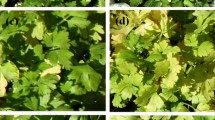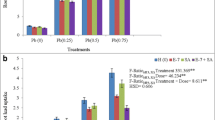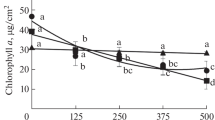Abstract
During phytoremediation of polycyclic aromatic hydrocarbons (PAHs) and heavy metals, the phytoremediation plants are often stressed by pollutants, which would reduce the efficiency of phytoremediation. The addition of organic acids from root exudates could alleviate the stress. In this study, three organic acids (citric acid, succinic acid, glutaric acid) were added to investigate the effects of organic acids on the stress response of Scirpus triqueter L. at two pyrene–lead concentrations. The activities of reactive oxygen species, malondialdehyde, plasma membrane H+-ATPase, and vacuolar H+-ATPase and PPase activity, as well as the activities of antioxidant enzymes (SOD, POD, and CAT) in Scirpus triqueter L. were determined. The addition of organic acids could effectively reduce the activities of reactive oxygen species, malondialdehyde, plasma membrane H+-ATPase, and vacuolar H+-ATPase and PPase activities. Under higher pollution, the damage of plant plasma membrane is more serious, but the addition of citric acid can alleviate this situation and even more effective than the relief under low pollution. The effect of citric acid was more significant than that of succinic acid and glutaric acid. These results demonstrated that organic acids could attenuate the stress of pyrene and lead to Scirpus triqueter L.





Similar content being viewed by others
References
Aebi H (1984) Catalase in vitro. Methods Enzymol 105:121–126
Al Mahmud J, Hasanuzzaman M, Nahar K, Rahman A, Hossain MS, Fujita M (2017) Maleic acid assisted improvement of metal chelation and antioxidant metabolism confers chromium tolerance in Brassica juncea L. Ecotoxiol Environ Saf 144:216–226
Apse MP, Aharon GS, Snedden WA, Blumwald E (1999) Salt tolerance conferred by overexpression of a vacuolar Na+/H+ antiport in Arabidopsis. Science 285(5431):1256–1258
Blumwald E, Poole RJ (1987) Salt tolerance in suspension cultures of sugar beet : induction of na/h antiport activity at the tonoplast by growth in salt. Plant Physiol 83(4):884–887
Buettner GR (2015) Moving free radical and redox biology ahead in the next decade(s). Free Radic Biol Med 78:236–238
Clemens S, Palmgren MG, Kramer U (2002) A long way ahead: understanding and engineering plant metal accumulation. Trends Plant Sci 7(7):309–315
Ding YZ, Song ZG, Feng RW, Guo JK (2014) Interaction of organic acids and pH on multi-heavy metal extraction from alkaline and acid mine soils. Int J Environ Sci Technol 11(1):33–42
Drzewiecka K, Mleczek M, Gasecka M, Magdziak Z, Golinski P (2012) Changes in Salix viminalis L. cv. ‘Cannabina’ morphology and physiology in response to nickel ions—hydroponic investigations. J Hazard Mater 217:429–438
Erdal S, Genisel M, Turk H, Dumlupinar R, Demir Y (2015) Modulation of alternative oxidase to enhance tolerance against cold stress of chickpea by chemical treatments. J Plant Physiol 175:95–101
Fu HJ, Yu HY, Li TX, Zhang XZ (2018) Influence of cadmium stress on root exudates of high cadmium accumulating rice line (Oryza sativa L.). Ecotoxicol Environ Saf 150:168–175
Gupta M, Sharma P, Sarin NB, Sinha AK (2009) Differential response of arsenic stress in two varieties of Brassica juncea L. Chemosphere 74(9):1201–1208
Gupta S, Pathak B, Fulekar MH (2015) Molecular approaches for biodegradation of polycyclic aromatic hydrocarbon compounds: a review. Rev Environ Sci Biotechnol 14(2):241–269
Hassan FAS, Ali EF, Alamer KH (2018) Exogenous application of polyamines alleviates water stress-induced oxidative stress of Rosa damascena Miller var. trigintipetala Dieck. S Afr J Bot 116:96–102
Hawrylak-Nowak B, Dresler S, Matraszek R (2015) Exogenous malic and acetic acids reduce cadmium phytotoxicity and enhance cadmium accumulation in roots of sunflower plants. Plant Physiol Biochem 94:225–234
Hoth S, Dreyer I, Dietrich P, Becker D, Muller-Rober B, Hedrich R (1997) Molecular basis of plant-specific acid activation of K+ uptake channels. Proc Natl Acad Sci U S A 94(9):4806–4810
Hou Y, Liu X, Zhang X, Chen X, Tao K (2016) Effects of key components of S-triqueter root exudates on fractions and bioavailability of pyrene-lead co-contaminated soils. Int J Environ Sci Technol 13(3):887–896
Huang YX, Zhang DF, Xu ZH, Yuan SJ, Li YS, Wang L (2017) Effect of overlying water pH, dissolved oxygen and temperature on heavy metal release from river sediments under laboratory conditions. Arch Environ Prot 43(2):28–36
Jiang MY, Zhang JH (2001) Effect of abscisic acid on active oxygen species, antioxidative defence system and oxidative damage in leaves of maize seedlings. Plant Cell Physiol 42(11):1265–1273
Jung S, Hutsch BW, Schubert S (2017) Salt stress reduces kernel number of corn by inhibiting plasma membrane H+-ATPase activity. Plant Physiol Biochem 113:198–207
Liu XY, Hu XX, Zhang XY, Chen XP, Chen J, Yuan XY (2018) Effect of Bacillus subtilis and NTA-APG on pyrene dissipation in phytoremediation of nickel co-contaminated wetlands by Scirpus triqueter. Ecotoxicol Environ Saf 154:69–74
Ma JF, Ryan PR, Delhaize E (2001) Aluminium tolerance in plants and the complexing role of organic acids. Trends Plant Sci 6(6):273–278
Martiniere A, Bassil E, Jublanc E, Alcon C, Reguera M, Sentenac H, Blumwald E, Paris N (2013) In vivo intracellular pH measurements in tobacco and Arabidopsis reveal an unexpected pH gradient in the endomembrane system. Plant Cell 25(10):4028–4043
Medina R, David Gara PM, Fernandez-Gonzalez AJ, Rosso JA, Del Panno MT (2018) Remediation of a soil chronically contaminated with hydrocarbons through persulfate oxidation and bioremediation. Sci Total Environ 618:518–530
Noctor G, Foyer CH (1998) Ascorbate and glutathione: keeping active oxygen under control. Annu Rev Plant Physiol Plant Mol Biol 49:249–279
Ondrasek G, Rengel Z, Romic D (2018) Humic acids decrease uptake and distribution of trace metals, but not the growth of radish exposed to cadmium toxicity. Ecotoxicol Environ Saf 151:55–61
Ozfidan-Konakci C, Yildiztugay E, Bahtiyar M, Kucukoduk M (2018) The humic acid-induced changes in the water status, chlorophyll fluorescence and antioxidant defense systems of wheat leaves with cadmium stress. Ecotoxicol Environ Saf 155:66–75
Reddy AM, Kumar SG, Jyothsnakumari G, Thimmanaik S, Sudhakar C (2005) Lead induced changes in antioxidant metabolism of horsegram (Macrotyloma uniflorum (Lam.) Verdc.) and bengalgram (Cicer arietinum L.). Chemosphere 60(1):97–104
Shahbaz AK, Lewinska K, Iqbal J, Ali Q, Mahmood-ur-Rahman, Iqbal M, Abbas F, Tauqeer HM, Ramzani PMA (2018) Improvement in productivity, nutritional quality, and antioxidative defense mechanisms of sunflower (Helianthus annuus L.) and maize (Zea mays L.) in nickel contaminated soil amended with different biochar and zeolite ratios. J Environ Manag 218:256–270
Shamshad S, Shahid M, Rafiq M, Khalid S, Dumat C, Sabir M, Murtaza B, Farooq AU, Shah NS (2018) Effect of organic amendments on cadmium stress to pea: a multivariate comparison of germinating vs young seedlings and younger vs older leaves. Ecotoxicol Environ Saf 151:85–91
Sharma B, Kothari R, Singh RP (2018) Growth performance, metal accumulation and biochemical responses of Palak (Beta vulgaris L. var. Allgreen H-1) grown on soil amended with sewage sludge-fly ash mixtures. Environ Sci Pollut Res Int 25(13):12619–12640
Shri M, Kumar S, Chakrabarty D, Trivedi PK, Mallick S, Misra P, Shukla D, Mishra S, Srivastava S, Tripathi RD, Tuli R (2009) Effect of arsenic on growth, oxidative stress, and antioxidant system in rice seedlings. Ecotoxicol Environ Saf 72(4):1102–1110
Singh N, Ma LQ, Srivastava M, Rathinasabapathi B (2006) Metabolic adaptations to arsenic-induced oxidative stress in Pteris vittata L and Pteris ensiformis L. Plant Sci 170(2):274–282
Solgi E, Esmaili-Sari A, Riyahi-Bakhtiari A, Hadipour M (2012) Soil contamination of metals in the three industrial estates, Arak, Iran. Bull Environ Contam Toxicol 88(4):634–638
Tang W, Newton RJ (2005) Polyamines reduce salt-induced oxidative damage by increasing the activities of antioxidant enzymes and decreasing lipid peroxidation in Virginia pine. Plant Growth Regul 46(1):31–43
van den Wijngaard PW, Sinnige MP, Roobeek I, Reumer A, Schoonheim PJ, Mol JN, Wang M, De Boer AH (2005) Abscisic acid and 14-3-3 proteins control K channel activity in barley embryonic root. Plant J 41(1):43–55
Velikova V, Yordanov I, Edreva A (2000) Oxidative stress and some antioxidant systems in acid rain-treated bean plants—protective role of exogenous polyamines. Plant Sci 151(1):59–66
Wang XT, Hu BP, Cheng HX, Jia HH, Zhou Y (2018) Spatial variations, source apportionment and potential ecological risks of polycyclic aromatic hydrocarbons and synthetic musks in river sediments in Shanghai, China. Chemosphere 193:108–117
Yan F, Zhu YY, Muller C, Zorb C, Schubert S (2002) Adaptation of H+-pumping and plasma membrane H+ ATPase activity in proteoid roots of white lupin under phosphate deficiency. Plant Physiol 129(1):50–63
Zhan XH, Yi X, Yue L, Fan XR, Xu GH, Xing BS (2015) Cytoplasmic pH-stat during phenanthrene uptake by wheat roots: a mechanistic consideration. Environ Sci Technol 49(10):6037–6044
Zhang WF, Zhang F, Raziuddin R, Gong HJ, Yang ZM, Lu L, Ye QF, Zhou WJ (2008) Effects of 5-aminolevulinic acid on oilseed rape seedling growth under herbicide toxicity stress. J Plant Growth Regul 27(2):159–169
Zhang JZ, Li XY, Zhou L, Wang LH, Zhou Q, Huang XH (2016) Analysis of effects of a new environmental pollutant, bisphenol A, on antioxidant systems in soybean roots at different growth stages. Sci Rep 6:23782
Zhou WJ, Leul M (1999) Uniconazole-induced tolerance of rape plants to heat stress in relation to changes in hormonal levels, enzyme activities and lipid peroxidation. Plant Growth Regul 27(2):99–104
Zhou XG, Yu GB, Wu FZ (2011) Effects of intercropping cucumber with onion or garlic on soil enzyme activities, microbial communities and cucumber yield. Eur J Soil Biol 47(5):279–287
Zhou Y, He WZ, Zheng WL, Tan QL, Xie ZZ, Zheng CS, Hu CX (2018) Fruit sugar and organic acid were significantly related to fruit Mg of six citrus cultivars. Food Chem 259:278–285
Zouari M, Ben Ahmed C, Elloumi N, Bellassoued K, Delmail D, Labrousse P, Ben Abdallah F, Ben Rouina B (2016) Impact of proline application on cadmium accumulation, mineral nutrition and enzymatic antioxidant defense system of Olea europaea L. cv Chemlali exposed to cadmium stress. Ecotoxicol Environ Saf 128:195–205
Funding
This work was funded by the National Natural Science Foundation of China (Nos. 21677093, 41373097) and Natural Science Foundation of Shanghai (No. 18ZR1414100).
Author information
Authors and Affiliations
Corresponding author
Ethics declarations
Conflict of interest
The authors declare that they have no conflict of interest.
Additional information
Responsible editor: Elena Maestri
Publisher’s note
Springer Nature remains neutral with regard to jurisdictional claims in published maps and institutional affiliations.
Rights and permissions
About this article
Cite this article
Zhang, X., Chen, J., Liu, X. et al. The relief effects of organic acids on Scirpus triqueter L. under pyrene–lead stress. Environ Sci Pollut Res 26, 15828–15837 (2019). https://doi.org/10.1007/s11356-019-04976-8
Received:
Accepted:
Published:
Issue Date:
DOI: https://doi.org/10.1007/s11356-019-04976-8




